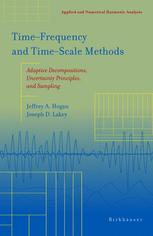

Most ebook files are in PDF format, so you can easily read them using various software such as Foxit Reader or directly on the Google Chrome browser.
Some ebook files are released by publishers in other formats such as .awz, .mobi, .epub, .fb2, etc. You may need to install specific software to read these formats on mobile/PC, such as Calibre.
Please read the tutorial at this link: https://ebookbell.com/faq
We offer FREE conversion to the popular formats you request; however, this may take some time. Therefore, right after payment, please email us, and we will try to provide the service as quickly as possible.
For some exceptional file formats or broken links (if any), please refrain from opening any disputes. Instead, email us first, and we will try to assist within a maximum of 6 hours.
EbookBell Team

4.8
104 reviewsDeveloped in this book are several deep connections between time--frequency (Fourier/Gabor) analysis and time--scale (wavelet) analysis, emphasizing the powerful adaptive methods that emerge when separate techniques from each area are properly assembled in a larger context. While researchers at the forefront of developments in time--frequency and time--scale analysis are well aware of the benefits of such a unified approach, there remains a knowledge gap in the larger community of practitioners about the precise strengths and limitations of Fourier/Gabor analysis versus wavelets. This book fills that gap by presenting the interface of time--frequency and time--scale methods as a rich area of work.
Topics and Features:
* Inclusion of historical, background material such as the pioneering ideas of von Neumann in quantum mechanics and Landau, Slepian, and Pollak in signal analysis
* Presentation of self-contained core material on wavelets, sampling reconstruction of bandlimited signals, and local trigonometric and wavelet packet bases
* Development of connections based on perspectives that emerged after the wavelet revolution of the 1980s
* Integrated approach to the use of Fourier/Gabor methods and wavelet methods
* Comprehensive treatment of Fourier uncertainty principles
* Explanations at the end of each chapter addressing other major developments and new directions for research
Applied mathematicians and engineers in signal/image processing and communication theory will find in the first half of the book an accessible presentation of principal developments in this active field of modern analysis, as well as the mathematical methods underlying real-world applications. Researchers and students in mathematical analysis, signal analysis, and mathematical physics will benefit from the coverage of deep mathematical advances featured in the second part of the work.